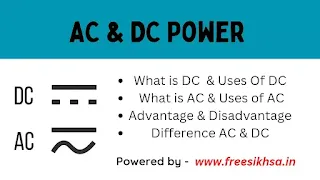What is Direct Current ?
Direct Current (DC) refers to the flow of electric charge in a circuit that always moves in the same direction. Unlike alternating current (AC), which periodically reverses direction, DC maintains a constant flow of electricity from the positive to the negative terminal of a power source.
Difference Between AC & DC Current
| AC Current | DC Current | |
|---|---|---|
| Definition | Electric charge periodically reverses direction | Electric charge flows in one direction only |
| Voltage | Alternates in direction and magnitude | Constant in magnitude and direction |
| Direction of Flow | Changes direction periodically | Flows in one direction only |
| Power Transmission | Suitable for long distance transmission | Less suitable for long distance transmission |
| Frequency | Frequency can be varied easily | Fixed frequency |
| Power Generation | Easily generated through transformers | Requires power electronics to convert from AC |
| Generation Source | Generated at power plants | Generated by batteries or electronic devices |
| Use in Homes and Buildings | Commonly used for powering homes and buildings | Commonly used for electronic devices and specialized applications |
| Efficiency | Less efficient in some applications, such as electronics | More efficient in some applications, such as electronics |
What is Used of DC in home appliances
Direct current is commonly used in electronic devices such as batteries, cell phones, and computers. It is also used in specialized applications such as electroplating and electric vehicles. The voltage of a DC power source can be fixed or adjustable, depending on the specific application
Where Can be generate DC power
DC power can be generated from a variety of sources, including batteries, solar cells, and generators. It is often used in combination with AC power in power distribution systems to provide a reliable and stable source of electricity
Advantage and Disadvantage of DC Current
| Advantages of DC power | Disadvantages of DC power |
|---|---|
| More efficient in certain applications: DC power can be more efficient in certain applications, such as powering electronic devices that require DC power to operate. | More difficult to transform voltage levels: DC power is more difficult to transform to different voltage levels, which can make it less suitable for long-distance power transmission. |
| Can be stored in batteries: DC power can be stored in batteries, making it more portable and useful for backup power | Less widely available and less widely used: DC power is less common than AC power and is generally used in more specialized applications. |
| Provides a constant voltage output: DC power provides a constant voltage output, which can be beneficial in certain applications that require a constant voltage output | More expensive to generate and distribute: DC power is generally more expensive to generate and distribute than AC power. |
| Can be used in some types of motors: DC power can be used to power some types of motors, such as brushless DC motors, which are efficient and reliable. | Can be less safe: DC power can be less safe than AC power, as it can cause electric shock if not handled properly, and is more difficult to interrupt if a fault occurs |
What is Alternating current ?
Alternating Current (AC) refers to the flow of electric charge in a circuit that periodically reverses direction. In other words, the flow of electricity in an AC circuit constantly changes direction, typically at a fixed frequency, such as 50 or 60 Hz.
Note : In India AC Power supply in 50Hz & Voltage Supply 230 Volts.
Why We Use Alternating Current (AC)
Because, One of the advantages of AC power is that it can be easily transformed to different voltage levels using a transformer. This makes it possible to transmit power over long distances with less energy loss than would be possible with DC power
AC power is used in a wide range of applications, from powering household appliances to running large industrial machinery. It is also used in electronic devices such as computers and televisions, which often require DC power to operate but use internal circuits to convert the AC power to DC power
Advantage and Disadvantage of AC Current
| Advantages of AC power | Disadvantages of AC power |
|---|---|
| Easy to transform voltage levels: AC power can be easily transformed to different voltage levels using a transformer. This makes it ideal for long-distance power transmission, where high voltages are needed to minimize energy loss over long distances. | Can be more dangerous if not handled properly: AC power can cause electric shock if not handled properly, due to its periodic reversal of direction. |
| Widely available and widely used: AC power is the most common form of electrical power used in homes and businesses around the world. It is generated at power plants and transmitted over long distances through power lines before being distributed to individual homes and businesses. | Can cause electromagnetic interference: AC power can cause electromagnetic interference (EMI) in electronic devices, which can cause distortion and affect their performance. |
| Lower cost: AC power is generally less expensive to generate and distribute than DC power. | The voltage output is not constant: The voltage output of AC power varies over time, which can be a disadvantage in certain applications that require a constant voltage output. |
| AC power can be used to connecting them in parallel to the same power source. | Less suitable for some applications: AC power may not be suitable for certain applications that require a constant voltage output or high-precision timing, such as in some types of motors and clocks. |
Conclusion
AC is generally better suited for long distance power transmission, while DC is more suitable for some types of electronics and specialized applications.


